- Overview
- Info & Inclusions
- Itinerary
- Map & Hotels
- Photos
- Dates & Prices
- Max Group Size 18
- A comprehensive regional tour including seven extremely varied countries
- Stately Belgrade
- Scenic mountain scenery
- Venerable Skopje
- Stunning Lake Ohrid
- Rugged and little visited Albania
- Pretty Dubrovnik
- Fascinating Bosnia-Herzegovina
- Singles friendly (view options for single travellers)
Countries elsewhere on the continent may be too expensive, too crowded and too commercialized. Today, the Western Balkans are authentic and accessible regions, where sidewalk cafes line cobblestone alleys and mediaeval castles loom over historic town centres.
An ethnically complex corner of the world where Catholic churches, Orthodox monasteries and Ottoman mosques share territory, the Balkans offer a true adventure to one of the less-travelled parts of the world.
- Full-time Tour leadder and local guide support
- Breakfast and dinner daily (mostly local restaurants).
- All transport, accommodation, sightseeing and entrance fees for sites noted as 'visited' in the detailed itinerary.
- Gratuities for local guides, drivers, restaurant staff, porters.
- Airport transfers for travellers who are arriving/departing on tour dates and book their air through us
- Any early arriving/late departing travellers who book both their air and extra nights through us.
- International airfare to/from the tour.
- Lunches, Tour Leader gratuities, drinks, personal items, air taxes (if applicable), and excursions referenced as 'optional'.
- Airport transfers for Land Only customers.
- Seasonality and Weather:
This tour is offered in spring and the fall when temperatures are mild. The region has a mild Mediterranean climate with autumns that are bright and warm into late October. Spring is warm and green. - Transport and Travel Conditions:
days, road travel is not particularly arduous as there are plenty of stops and beautiful scenery along the way. Roads are generally in good condition, though a little winding and slow on mountain roads (especially Albania).
This trip is typical of most of our European tours, which are ambitious and involve full days of travel and sightseeing. While we don't have any actual strenuous activity (ie hiking) built into the program, you will do a lot of walking on this trip. These walks will mostly be in the form of walking tours of towns and cities and short walks to dinner. Being Europe, and a hilly/mountainous area, cobblestone, uneven surfaces, and slopes/stairs are common. If you are accustomed to typical "bus tours" which heavily rely on vehicular transport for all sightseeing activities, you should be aware that this tour is considerably more active.
Am I suitable for this tour? Please refer to our self-assessment form - Activity Level: 2
These are particularly busy tours that feature a lot of moving around, sometimes by train and short journeys on local transport. Walking tours of towns and cities are leisurely but you should be prepared to be on your feet for several hours. Some of our cultural trips that occur at high altitude and/or require greater independence with baggage handling (at hotels, airports, train stations) also fall into this category.
To learn more about the Activity levels, please visit our tour styles page. - Accommodation:
Well-located, air-conditioned, mid-range hotels (3 & 4-star). Some hotels are smaller properties (3-4 story) that may not have elevators. Some Albanian hotels are of a simpler standard. Al hotels have en suite bath, though some may have shower only. Porter service is usually available (see 'inclusions') though you should be independent with your luggage.
Single rooms are limited and likely smaller than twins. - Staff and Support:
Tour Leader throughout, driver (s), local step-on guides in various locales. - Group Size:
Maximum 18 plus Tour Leader
- Day 1:Arrive in BelgradeWelcome to the Balkans. Today we arrive in Belgrade, Serbia's capital since 1403. This historic city occupies a strategic position at the confluence of the Sava and Danube rivers, a location that has made it a coveted prize for empires throughout history—from Rome to Byzantium, from the Ottomans to the Austro-Hungarians.
This evening we gather with fellow travellers for our first meal together.
Overnight in Belgrade.
Included Meal(s): Dinner, if required - Day 2:Belgrade: City TourThis morning we begin with a panoramic drive through Belgrade to orient ourselves to the city's layout. We see St. Sava Church, one of the world's largest Orthodox churches, and the Royal Palace complex on Dedinje Hill. Returning to the city centre, we continue on foot from Republic Square, where the National Theatre and National Museum face the main gathering point for locals.
Nearby, Skadarlija Street climbs steeply through what was once the Gypsy Quarter. This bohemian district, with its cobblestone lanes and 19th-century buildings, became Belgrade's artistic heart where writers and musicians gathered in traditional kafanas. We walk along Knez Mihailova, the main pedestrian promenade lined with buildings from the late 19th century, many housing shops and cafes today.
We visit Princess Ljubica's Residence, a 19th-century mansion that now displays period furniture and offers insight into aristocratic life. The nearby Kosancicev Venac Street preserves the atmosphere of old Belgrade with its traditional architecture and intimate scale.
Our tour concludes at Kalemegdan Park and Belgrade Fortress, positioned on the bluff where the Sava meets the Danube. Romans first fortified this strategic height in the 2nd century. The current walls, gates, and towers date mainly from the 18th century, though layers of earlier fortifications remain visible. From the ramparts we look across the rivers and the Pannonian Plain beyond.
Overnight in Belgrade.
Included Meal(s): Breakfast and Dinner - Day 3:Belgrade - Novi PazarWe travel south from Belgrade through Serbia's varied terrain—fertile plains giving way to limestone ranges and ancient hills. Our route follows the Ibar Valley into the Raska region, where a significant Muslim population distinguishes this area from the rest of Serbia. Unlike neighbouring Kosovo's Albanian Muslims, Raska's Muslims are ethnic Slavs. Minarets begin appearing on the skyline as we travel deeper into the valley.
This afternoon we visit Studenica Monastery, a UNESCO World Heritage site and the richest of Serbia's Orthodox monasteries. Founded between 1183 and 1196, the monastery's two principal churches—the Church of the Virgin and the Church of the King—contain exceptional collections of 13th and 14th-century Byzantine frescoes. The white marble facades and dome architecture represent the pinnacle of medieval Serbian ecclesiastical building.
We continue to Sopocani Monastery, also UNESCO-protected and dating to the 13th century. The interior frescoes rank among the finest examples of Byzantine painting, their colours and compositions remarkably preserved despite the monastery's turbulent history.
We proceed to the Kopaonik region for the night. Novi Pazar, the area's largest town, takes its name from the Turkish "new market"—a tradition that continues in the large open-air market north of the Raska River. The 16th-century Altum Alem Mosque still stands in the old bazaar area south of the river.
Overnight in Kopaonik.
Included Meal(s): Breakfast and Dinner - Day 4:Novi Pazar, Serbia - Pristina, KosovoThis morning we cross from Serbia into Kosovo, passing Kosovska Mitrovica—a city that remains divided along ethnic lines—before reaching Pristina, Kosovo's capital.
Kosovo declared independence from Serbia in February 2008. The United States and many European nations recognized this independence, while Serbia and its allies, notably Russia, rejected the declaration. The region's history reflects centuries of cultural collision and coexistence. Ottoman forces defeated a joint Serbian-Albanian army here in 1389, yet between periods of conflict, diverse communities lived peacefully together. Today's population is predominantly Muslim Albanian, with Orthodox Christian Serbs forming the second-largest group.
Pristina occupies the northeast edge of the Kosovo plain, positioned on the route between North Macedonia and Serbia. The city serves as Kosovo's economic and administrative centre, though international sanctions and ethnic conflict in the 1990s severely damaged the economy.
Our afternoon walking tour takes us through Pristina's lively bazaar, where the atmosphere typical of Balkan markets fills the narrow lanes. We see the 19th-century Ottoman clock tower and the Fatih Mosque, built in 1461 under Sultan Mehmet II. The Carshia Mosque, constructed in the 15th century, stands as Pristina's oldest building. We visit the Ethnographic Museum, housed in an 18th-century traditional house—one of few original structures remaining in the old bazaar.
Time permitting, we drive to Gracanica to see the monastery church, completed in 1321 by Serbian King Milutin Nemanjic. The building represents the height of Serbian Byzantine architecture, with frescoes that rank among Kosovo's finest medieval art.
Overnight in Pristina.
Included Meal(s): Breakfast and Dinner - Day 5:Pristina - Prizren, Kosovo - Skopje, North MacedoniaThis morning we travel south to Prizren, considered one of Kosovo's most beautiful towns. Positioned on the slopes of the Sharr Mountains where the Bistrica River flows through the valley, Prizren preserves exceptional architectural heritage. Traditional Ottoman houses with wooden balconies overlook gardens and narrow lanes wind up the hillside.
The 16th-century Sinan Pasha Mosque dominates the small centre. Unlike Pristina, Prizren retains many 18th and 19th-century Ottoman houses intact. The cobbled Shadervan Square contains several cafes, while upstream an arched stone bridge from the 15th century spans the river. Above the mosque, the road climbs past the 14th-century St. Saviour Church to the 11th-century Kaljaja Fortress, which commands views across the town and valley.
We visit the 12th-century Orthodox Cathedral Church of the Virgin of Levisa, listed on UNESCO's endangered heritage register. The interior frescoes date from the medieval period. The Albanian League of Prizren Museum displays national costumes and historical artifacts.
By afternoon we cross into North Macedonia and continue to Skopje, the capital. This landlocked, mountainous country declared independence from Yugoslavia in 1991. The landscape contains numerous valleys and lakes, with architectural heritage from both Byzantine and Ottoman periods evident in churches and mosques throughout the region.
Overnight in Skopje.
Included Meal(s): Breakfast and Dinner - Day 6:Skopje: City TourSkopje's name derives from its Byzantine-era role as a frontier observation post—the word means "watch-tower." The city occupies both banks of the Vardar River, its history stretching back over 2,000 years to when Romans knew it as Skupi. Byzantium, the First Bulgarian Empire, and the Ottoman Turks all ruled here at various periods.
The Old Bazaar developed between the Stone Bridge and Kale fortress during medieval times, reaching its zenith in the 16th and 17th centuries as one of the Balkans' largest oriental markets. Today the area retains significant historic monuments. We visit the Archaeological Museum during our walk through the old quarter.
The Stone Bridge, built by Turks in the 15th century, connects the bazaar to the modern town and remains a city symbol. Kale Fortress occupies the site where settlement began—Emperor Justinian founded the town of Justiniana Prima here in the 6th century. Ottoman forces later used the fortress as barracks from the 14th through 20th centuries.
We see the Mustafa Pasha Mosque, an Ottoman architectural achievement rising above the bazaar, and the Daut Pasha Hamam, a 15th-century bathhouse considered a masterpiece of Islamic civil architecture.
Overnight in Skopje.
Included Meal(s): Breakfast and Dinner - Day 7:Skopje - Lake OhridOur route today passes Lake Matka, where we stop for a walk along the shore, and continues through Tetovo to Mavrovo National Park. The park encompasses mountains, lakes, rivers, gorges and waterfalls in a protected landscape. In Tetovo we visit the Painted Mosque, constructed in 1459 on earlier foundations. The building exemplifies early Constantinople style, with elaborate painted decoration on both facade and interior—unique in North Macedonia. The turbe beside the mosque contains the remains of the two women who funded its construction.
We reach Ohrid by afternoon. This ancient town on the shores of Lake Ohrid represents the spiritual heart of Orthodox Macedonia. Saints Clement and Naum founded the first Slavic university here in the 9th century, establishing Ohrid as a centre of learning and religious life. The town dates to at least 353 BCE when it was known as Lychnidos; it received its current name in 879 CE.
UNESCO protects Ohrid as a World Heritage site for its concentration of churches, traditional architecture, and lakeside setting. The town's preservation and historical significance make it one of Europe's oldest continuously inhabited settlements.
Overnight in Ohrid.
Included Meal(s): Breakfast and Dinner - Day 8:Ohrid: Area TourThis morning we explore Ohrid's old town on foot. The ancient Greeks called this place Lychnidos, "City of Light." When Slavs arrived in the 10th century they renamed it Arida, and it became a major cultural centre. The Cyrillic alphabet originated here through the work of Saints Cyril and Methodius, establishing Ohrid as the cradle of Slavic written language.
Ohrid earned its nickname "City of 365 Churches" through centuries of religious construction. We visit St. Panteleimon Monastery, dating to the 9th century and recognized as the world's oldest Slav monastery. The town contains numerous archaeological sites, including a Roman amphitheatre and fortress ruins. We walk through the local bazaar where traditional crafts continue.
As the day draws to a close, we board a boat for a panoramic sunset cruise on Lake Ohrid. One of Europe's oldest and deepest lakes, Ohrid supports unique endemic species found nowhere else. From the water, we watch the sun descend behind the mountains, casting golden light across the ancient town's churches and fortress walls—a fitting conclusion to our time in this storied landscape.
Overnight in Ohrid.
Included Meal(s): Breakfast and Dinner - Day 9:Ohrid, North Macedonia - Berat, AlbaniaWe travel around Lake Ohrid and cross into Albania. This small country between the Adriatic and Ionian Seas remained isolated for decades under communist rule. Today Albania transitions toward an open-market economy while preserving its rich archaeological heritage—traces of Illyrian, Greek, Roman, Byzantine, and Ottoman civilizations appear throughout the landscape.
Our destination is Berat, known as the "city of one thousand windows" for its distinctive Ottoman architecture. UNESCO protects Berat as a museum city, and it ranks among Albania's most beautiful towns. Founded as Antipatrea, Berat climbs the slopes of Mount Tomorr, with a medieval castle commanding the heights.
We spend the afternoon touring the old town, one of the Balkans' best-preserved Ottoman urban centres. The inhabited citadel crowns the hill, its walls enclosing ruined mosques and several medieval Orthodox churches with restored frescoes. The Onufri Museum, housed in a church, displays Albania's finest icon collection—the work of 16th-century master painter Onufri and his son Nikolla.
In the lower town we see the Lead Mosque, named for its roof covering, along with the Bachelor's Mosque and Sultan's Mosque. The Ottoman han (inn) provides a glimpse of the city's commercial past when traders gathered here on routes between the interior and coast.
Overnight in Berat.
Included Meal(s): Breakfast and Dinner - Day 10:Berat - Apollonia - Durres - TiranaWe travel from Berat to Apollonia, Albania's largest archaeological site. Founded as a Greek colony in the 6th century BCE, Apollonia flourished during Hellenistic and Roman periods as an important city on the Via Egnatia. The ruins spread across a hillside, with a collection of artifacts displayed in a beautiful Orthodox monastery built before the 12th century.
We continue to Durres, Albania's second-largest city and one of its oldest settlements. According to legend, Illyrian King Epidamnos founded the city and named the port after his grandson Dyrrah. For centuries Durres served as the Adriatic's largest port. In 1939, Italian troops invaded here, and those killed defending the city are remembered as the first martyrs of Albania's War of National Liberation.
We visit Durres' Roman amphitheatre, the Balkans' largest, built in the 1st century and under consideration for UNESCO protection. Behind the Aleksander Moisiu Theatre on the central square, we see ruins of the Roman Baths.
By late afternoon we reach Tirana, Albania's capital.
Overnight in Tirana.
Included Meal(s): Breakfast and Dinner - Day 11:Tirana: City TourTirana occupies a beautiful setting between the Dajti Mountains and coastal plains. The city was founded in 1614 by feudal lord Sulejman Pasha Bargjini, though the area has been inhabited since Neolithic times. Tirana became the capital in 1920.
Our tour includes a walk along the Boulevard of the Martyrs, where most of Tirana's significant buildings concentrate. Skanderbeg Square, named for the national hero who defeated Ottoman forces in the 15th century, forms the city centre. The Et'hem Bey Mosque, dating to 1794, stands on the square—one of Tirana's finest buildings. The adjacent Clock Tower was built in 1822.
We visit BunkArt, a former nuclear bunker converted into an art and history exhibition that documents Albania's communist era. We also take the cable car to Dajti Mountain for panoramic views across the city and surrounding landscape.
Overnight in Tirana.
Included Meal(s): Breakfast and Dinner - Day 12:Tirana - Kruja - Shkodra, Albania - Podgorica, Montenegro - BudvaWe travel first to Kruja, a town perched high on a hillside and the historic centre of 15th-century Albanian resistance under Skanderbeg against Ottoman expansion. We visit the Ethnographic Museum, which preserves examples of traditional Albanian architecture and highland culture. The street leading through the old quarter replicates a traditional Turkish bazaar with shops and workshops.
We continue to Shkoder, known to Illyrians as Scodra and one of Europe's oldest cities. Shkoder represents the traditional centre of Gheg culture and contains numerous historical monuments, including the ancient Rozafa Castle commanding the heights above the town.
After crossing into Montenegro, we travel alongside Lake Skadar—the Balkans' largest lake—toward the Montenegrin coast. We reach Budva by evening. This medieval walled town on the Adriatic Riviera attracts visitors with its fortified old quarter, where narrow stone-paved streets wind between Venetian-era buildings clustered around the main cathedral.
Overnight in Budva.
Included Meal(s): Breakfast and Dinner - Day 13:Budva - Kotor, Montenegro - Dubrovnik, CroatiaThis morning we explore Budva's old town on foot. Much of the architecture reflects Venetian influence—doors, windows, balconies and decorative details recall the Republic of Venice's long presence along this coast.
We drive north along the Bay of Kotor, often compared to a Norwegian fjord for its dramatic topography—bare mountains plunging into deep water. At the bay's head sits Kotor, a UNESCO World Heritage town. This medieval settlement, tucked beneath towering cliffs, dates to Illyrian and Roman times. Kotor's 4.5-kilometre fortification walls, numerous churches, and palaces earned UNESCO protection in 1979. Most visible monuments date from the 14th through 18th centuries.
Our walking tour includes the Cathedral of St. Tryphon, St. Luke's Church, and St. Michael's Church. We walk through Kotor's spacious squares lined with palaces and explore sections of the fortifications, which climb the mountainside behind the town.
From Perast, a historic seafaring village, we board a boat for a short cruise on the bay. Two tiny islands support churches—the natural island of St. George hosts a monastery sheltered by cypresses, while an artificial island holds the Chapel of Our Lady of the Rocks, which we visit. The chapel contains votive paintings and silverwork donated by sailors over centuries.
We continue along the coast to Dubrovnik, crossing from Montenegro into Croatia. The route offers views of the bay, fishing villages, and the dramatic coastal mountains.
Overnight in Dubrovnik.
Included Meal(s): Breakfast and Dinner - Day 14:Dubrovnik: City TourThis morning we explore Dubrovnik's Old Town on foot. A UNESCO World Heritage site since 1979, Dubrovnik earned epithets like "Pearl of the Adriatic" for its beauty and sophisticated history. The 1667 earthquake destroyed much of the medieval city, and more recently, bombardment in 1991-92 caused severe damage. Extensive restoration has returned the city to its former glory—red-tiled roofs, towering fortifications, and limestone-paved streets once again characterize this historic port.
We enter through Pile Gate, as motor vehicles cannot access the walled city. Stradun (officially Placa) runs from Pile Gate in the west to Ploce Gate in the east, connecting the Old Town's two main entrances. The uniform Baroque buildings lining this limestone-paved street date from post-earthquake reconstruction.
We visit the Franciscan Monastery, notable for Europe's oldest functioning pharmacy (operating since 1317) and remnants of medieval frescoes. The Rector's Palace, now a museum, exemplifies Renaissance architecture. The Cathedral's dome dominates the skyline. Along our route we see Onofrio's Fountain, the Clock Tower, Orlando's Column, and Gundulic Square. We walk to the old harbour, essential to Dubrovnik's prosperity as a maritime republic.
We also walk sections of the city walls, nearly 2 kilometres in circuit. Built mainly in the 15th century, the walls and bastions provide elevated views across the old town, harbour, and Adriatic beyond.
Overnight in Dubrovnik.
Included Meal(s): Breakfast and Dinner - Day 15:Dubrovnik , Croatia - Pocitelj - Kravica Waterfall - Mostar, Bosnia & HerzegovinaToday we travel inland into the mountains, crossing into Bosnia and Herzegovina. This region's history extends to medieval times, with layers of Ottoman and Austro-Hungarian influence shaping the landscape.
We stop at Pocitelj, a unique hillside town with Ottoman architecture. UNESCO protects this settlement for its oriental character. The Sahat Kula, a cylindrical fort, crowns the hill above town—watchmen once guarded from here against invasion from the Neretva Valley below.
We visit Domano Winery on the Dubrava Plateau, known for sparkling Zilavka wine—Bosnia's first and only sparkling wine. We also see Kravica Waterfall, where water cascades 25 metres (82 feet) down a limestone cliff into a large pool.
By afternoon we reach Mostar, a town over 500 years old. The famous arched bridge that gives Mostar its name originally stood in wood, built in the early 15th century as a vital link across the Neretva River. The stone bridge that replaced it became the town's defining feature, connecting the two banks and facilitating trade between the coast and interior Herzegovina.
Overnight in Mostar.
Included Meal(s): Breakfast and Dinner - Day 16:Mostar: Walking Tour & BlagajThis morning we explore Mostar on foot. The town began as a small settlement at a strategic Neretva River crossing. Its hinterland consisted of agricultural plains on the west bank and steep terraces backed by mountains on the east. Mostar developed as a multi-ethnic settlement with an independent political identity from the 12th century.
The historic old town developed in the 15th and 16th centuries as an Ottoman frontier settlement. The Old Bridge (Stari Most), completed in 1566, gives Mostar its name—"bridge keeper." Destroyed in 1993 during the Bosnian War, the bridge was reconstructed using traditional methods and reopened in 2004. UNESCO inscribed the Old Bridge Area as a World Heritage site in 2005, recognizing it as a symbol of reconciliation and coexistence.
We visit Koski Mehmed Pasha Mosque (1618) and walk through the Kujundziluk bazaar street with its craft shops and galleries. The Kriva Cuprija (Crooked Bridge) over Rabobolja creek resembles a miniature version of Stari Most. We see Karadzozbe Mosque (1577) and the Turkish House (Biscevica House) from 1635.
This afternoon we visit Blagaj village. The Buna Spring flows from a 200-metre cliff face, creating the Buna River at a single dramatic point. The Ottoman-era Tekija, a Dervish monastery built into the cliff beside the spring in the 16th century, remains one of Bosnia's most atmospheric sites. We walk through Blagaj's old town, seeing the 17th-century Velagic House and old flourmills powered by the Buna's strong current.
Overnight in Mostar.
Included Meal(s): Breakfast and Dinner - Day 17:Mostar - Sarajevo: City TourOur drive from Mostar to Sarajevo ranks among the tour's most scenic—the route follows the Neretva River through mountain valleys, passing small farms and snow-capped peaks.
We stop at the Neretva Train Bridge in Jablanica, a railway bridge destroyed and rebuilt multiple times, most notably during World War II's Battle of the Neretva. The ruins stand as a memorial to that conflict's devastation.
In Konjic we visit Tito's Bunker, a massive underground complex built during the Cold War as a nuclear shelter and command centre for Yugoslav leader Josip Broz Tito. The bunker's tunnels, command rooms, and living quarters offer insight into Cold War paranoia and preparations.
Approaching Sarajevo, we stop at viewpoints overlooking the city and visit the Sarajevo War Tunnel Museum. During Sarajevo's 1,400-day siege in the 1990s, this tunnel provided the only reliable supply route into the isolated city, serving as a lifeline for residents.
Overnight in Sarajevo.
Included Meal(s): Breakfast and Dinner - Day 18:Sarajevo: City TourSarajevo spent over 300 years under Ottoman governance before Austro-Hungarian rule arrived in the late 19th century. The empire collapsed in 1914 when Archduke Franz Ferdinand was assassinated here, precipitating World War I. In 1984 Sarajevo hosted the Winter Olympics. A decade later, the city endured a prolonged siege during the Bosnian War.
Our tour explores the old town where Sarajevo's medieval origins remain visible. Bascarsija, the heart of Ottoman Sarajevo, began construction in 1462 and reached its peak by the mid-16th century. The quarter's streets still bear names of the 80+ trades that once operated here.
We visit Svrzo House, built in the 18th century and representing authentic Ottoman-era Bosnian architecture. The Ghazi Husref-Bey Mosque ranks among Bosnia's most important Islamic buildings. At the Latin Bridge, dating to 1798, we mark the spot where Archduke Ferdinand's assassination occurred on June 28, 1914—the event that triggered World War I.
We also see the City Hall (Vijecnica), completed in 1896 and exemplifying pseudo-Moorish architecture, and the Old Orthodox Church from the 16th century.
Overnight in Sarajevo.
Included Meal(s): Breakfast and Dinner - Day 19:DepartOur journey through the Balkans concludes as we depart from Sarajevo.
From Belgrade's riverside fortress to Sarajevo's Ottoman heart, from the heights of Kotor's walls to the depths of Tito's bunker, we've traced centuries of history across this complex, beautiful region where civilizations, religions, and cultures converge.
Bon voyage! Srecan put!
Included Meal(s): Breakfast
Countries Visited: Albania, Bosnia and Herzegovina, Croatia, Kosovo, North Macedonia, Montenegro and Serbia
*The red tour trail on the map does not represent the actual travel path.


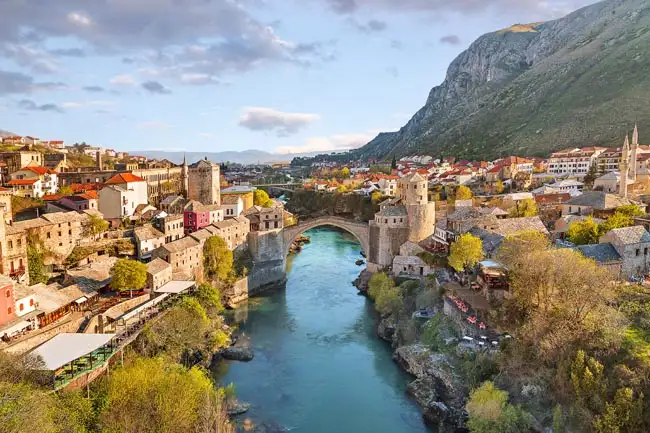
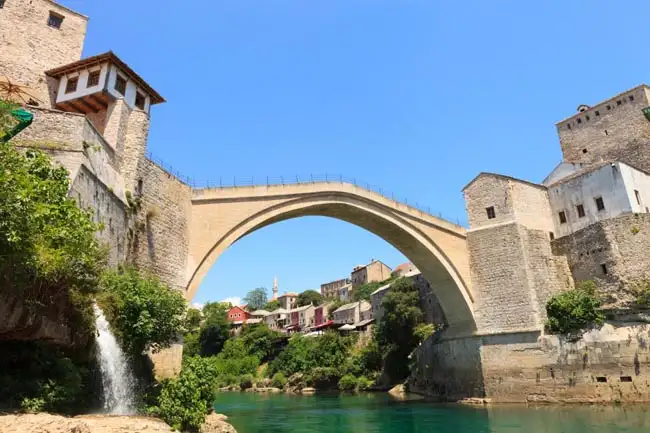
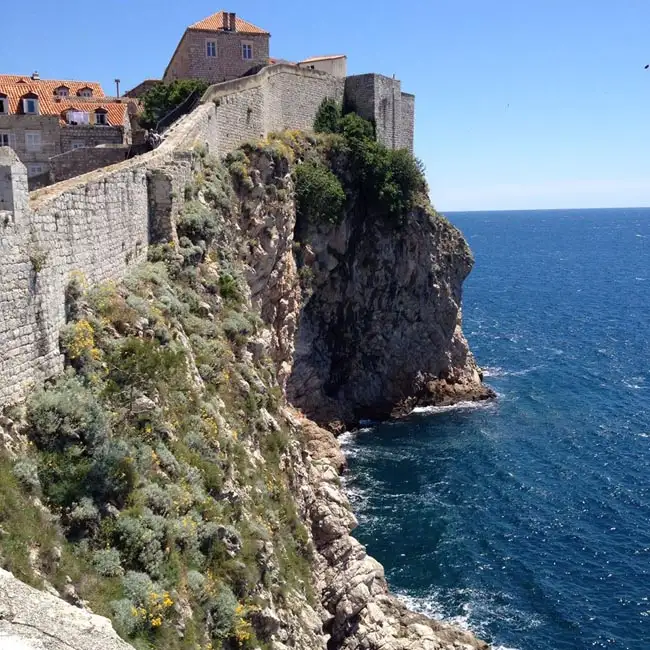
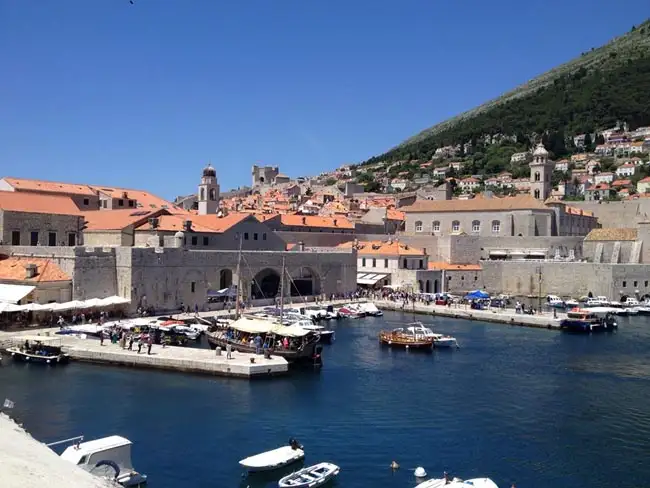
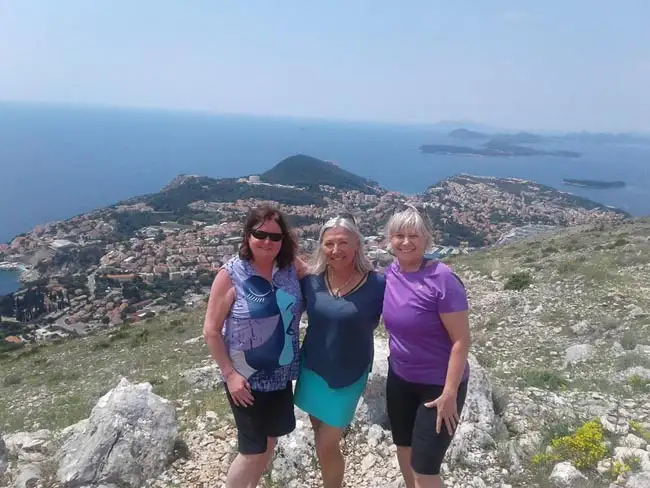
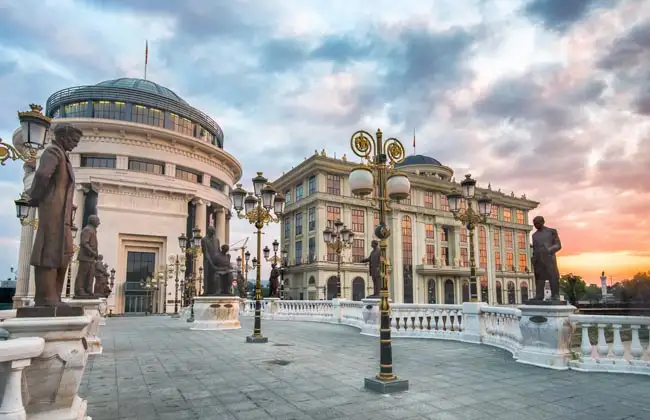

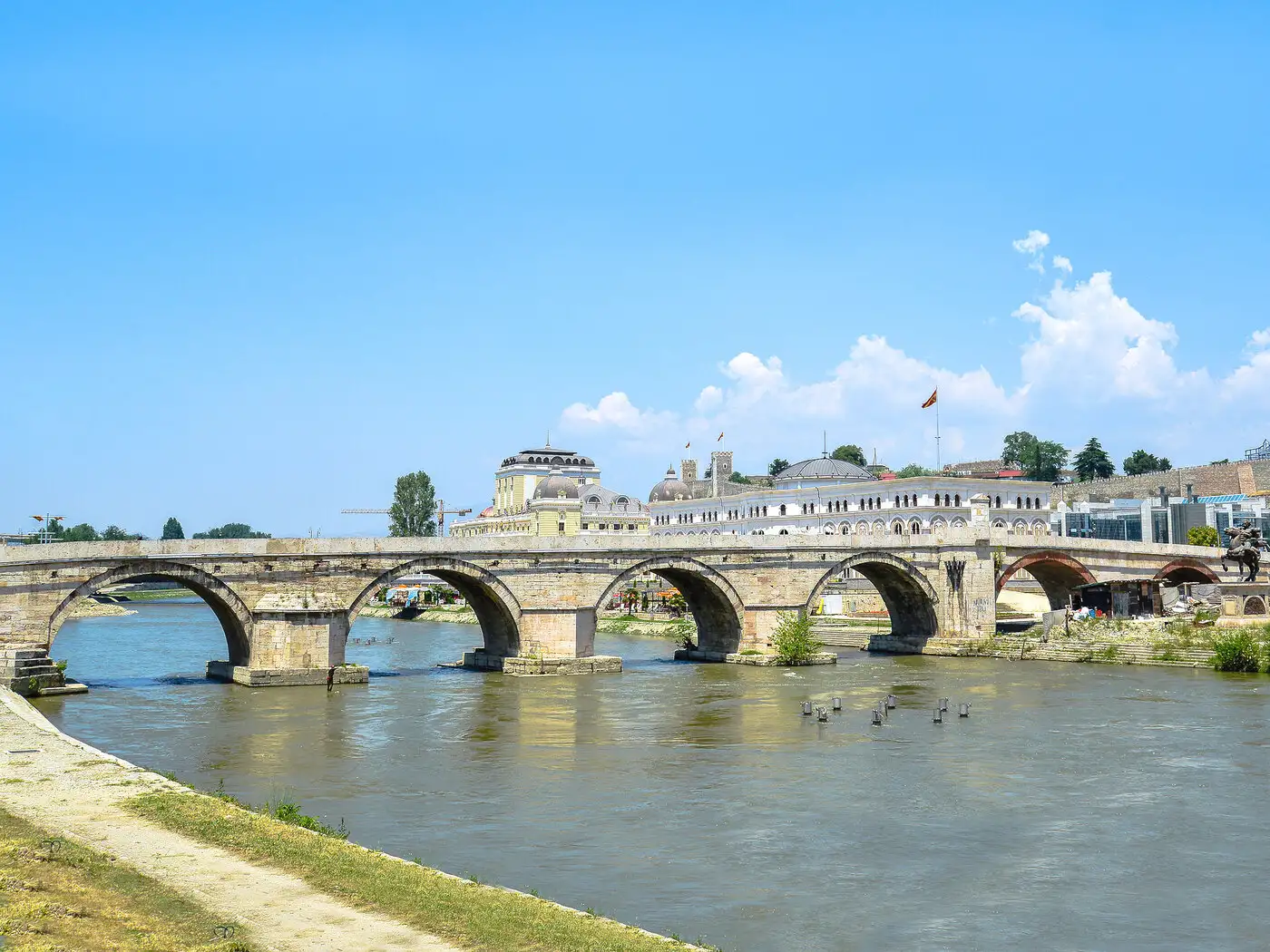
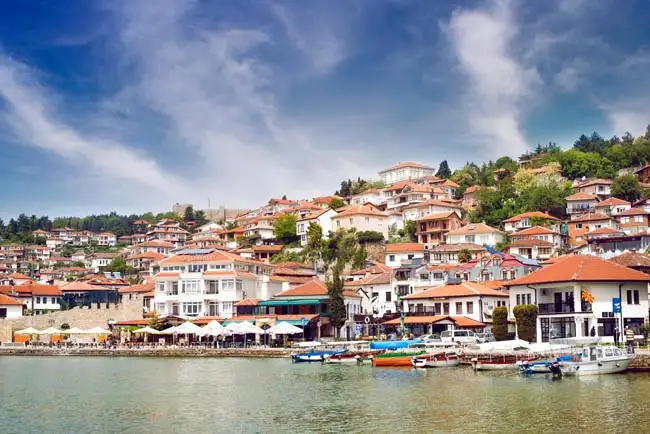

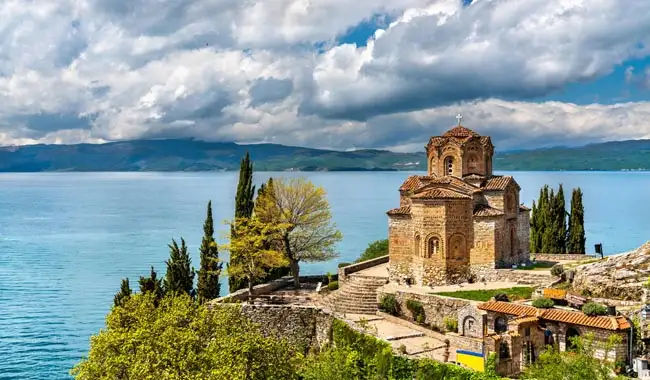

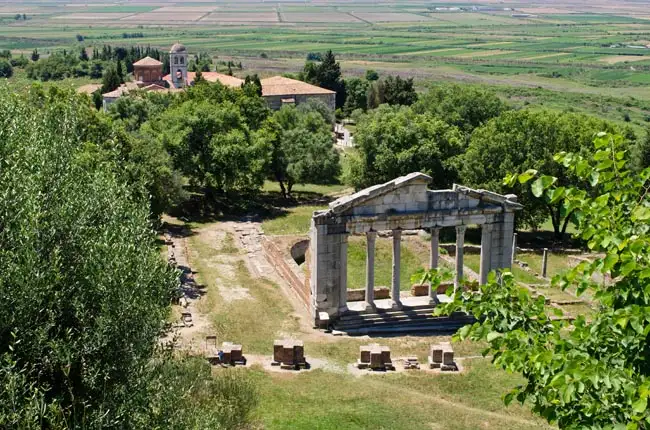
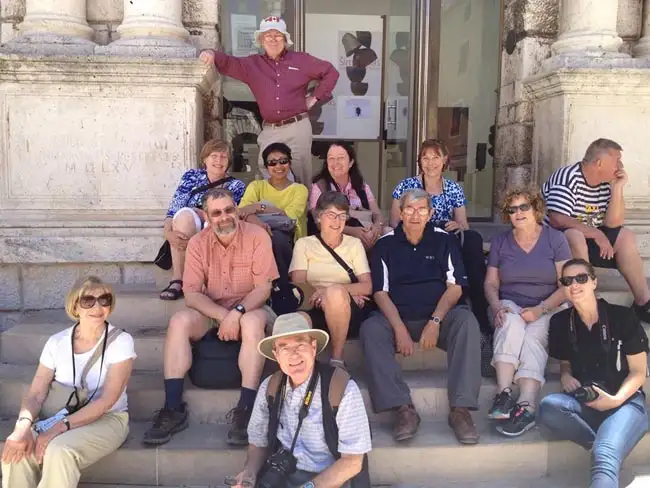
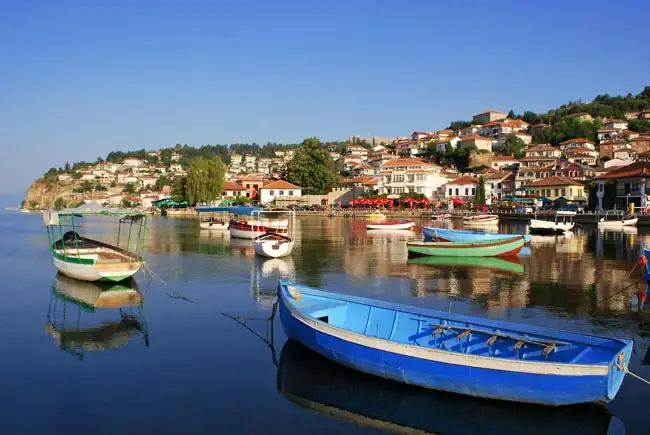
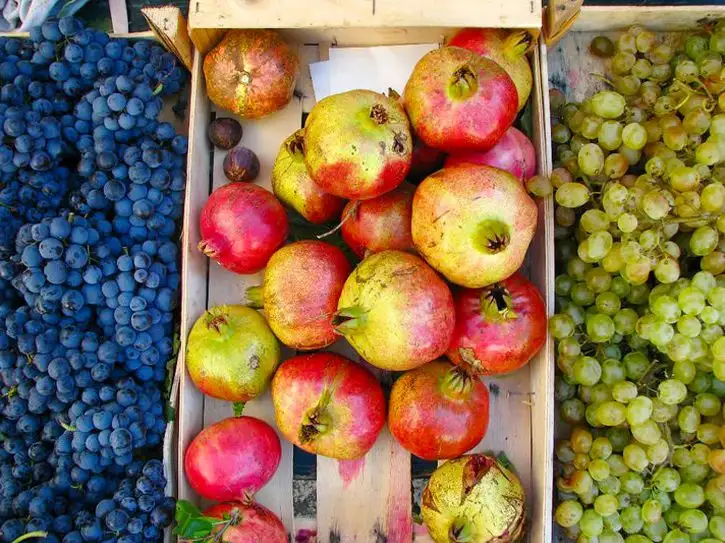
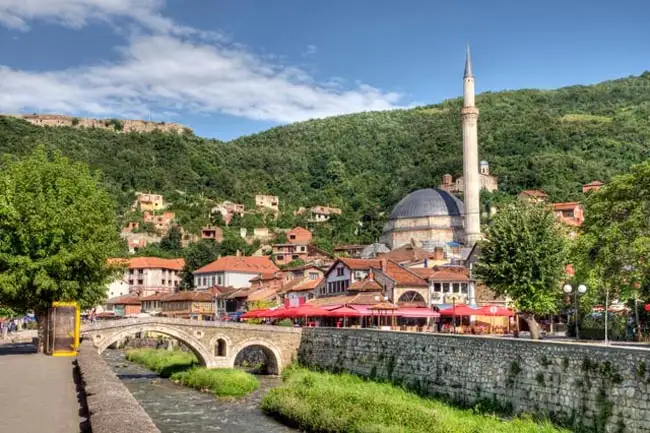

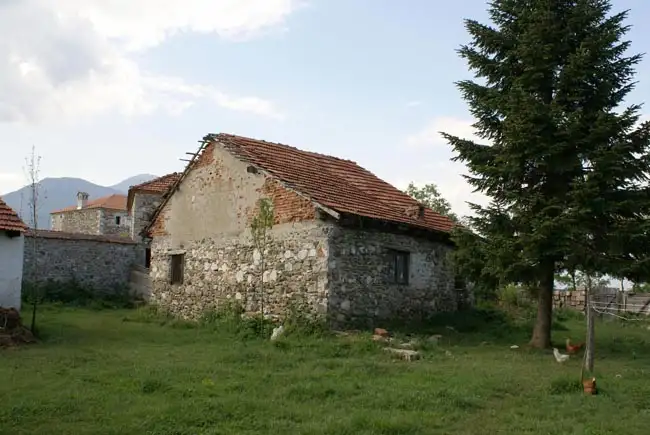


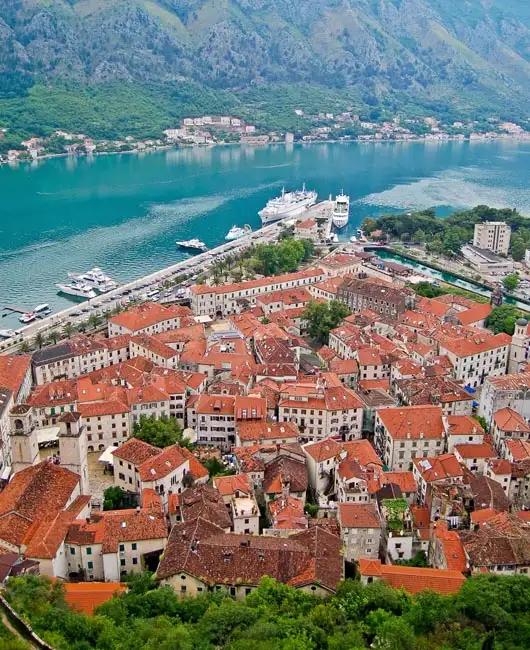
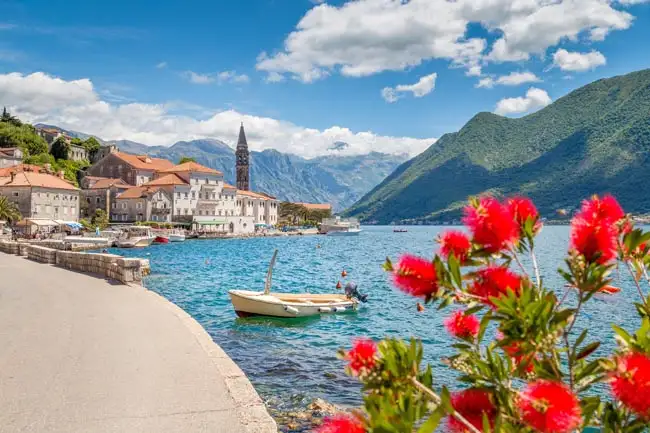
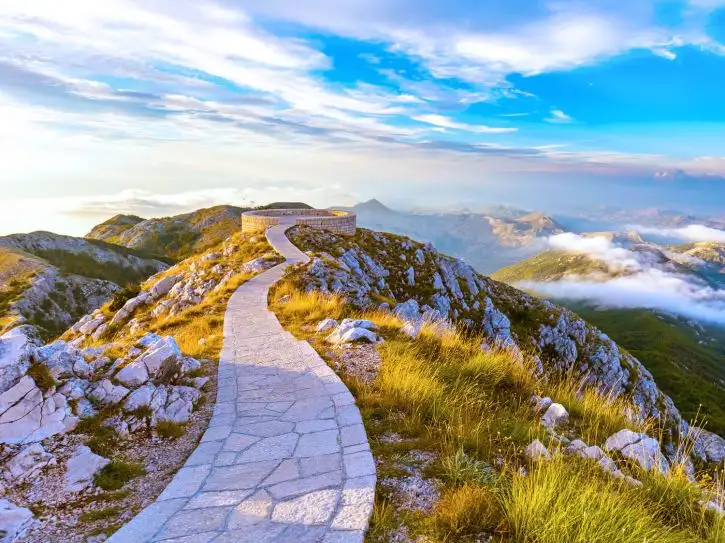
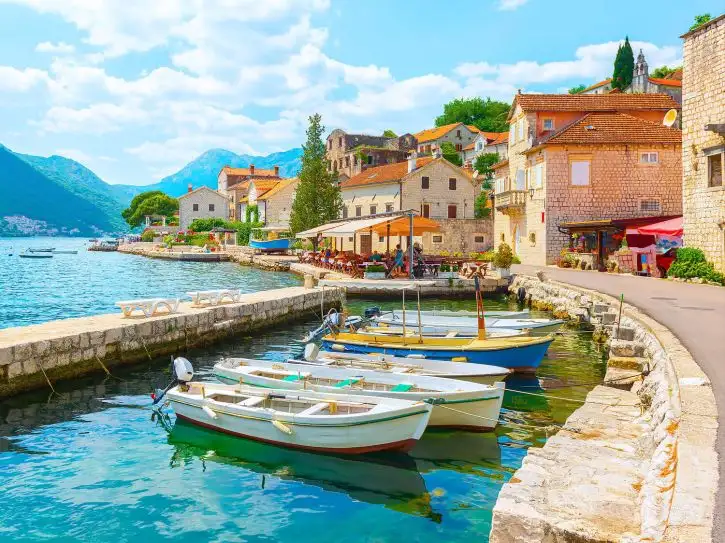

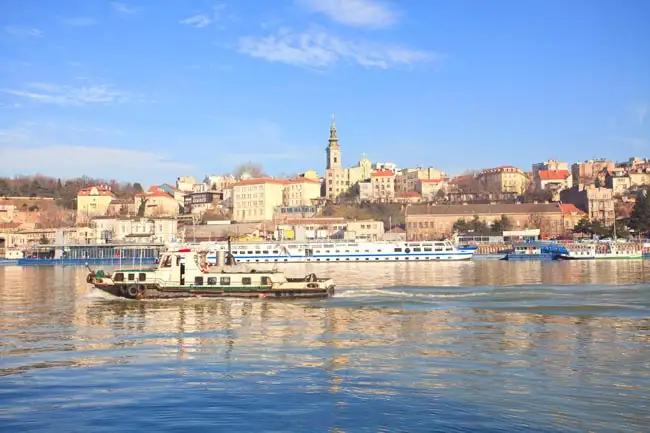

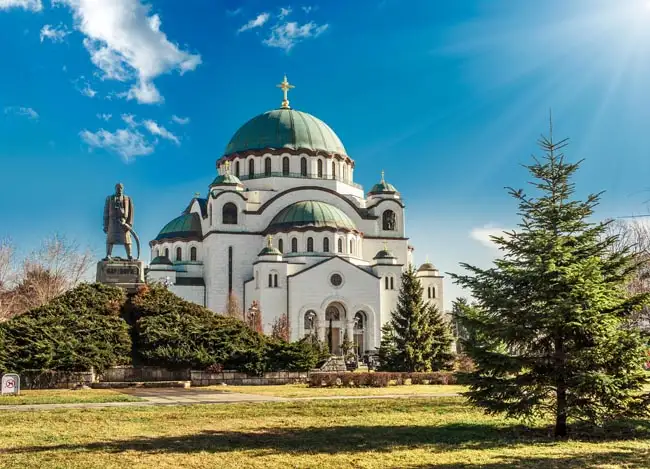
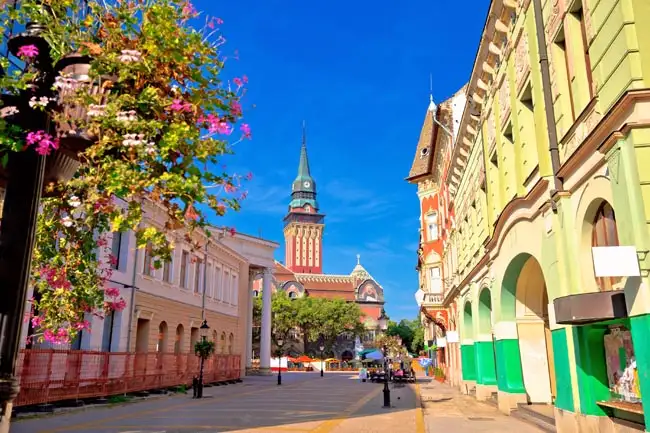
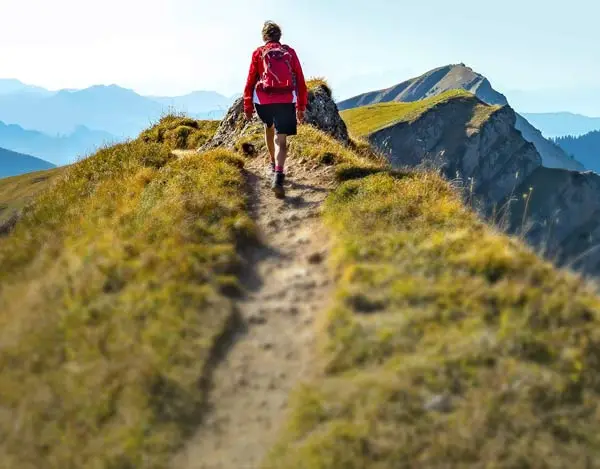
Book This Tour
- Final payment: Due 90 days prior to departure.
- Deposit: A non-refundable $1000 CAD Deposit is required at booking.
- Optional Single Supplement: $1950 CAD (number of singles limited).
(View options forsingle travellers) - Transfering Tour or Date: Transferring to another tour or tour date is only permissible outside of 120 days prior to departure and is subject to a $100 CAD change fee.
(Read our cancellation policy)
Prices below are per person, twin-sharing costs in Canadian Dollars (CAD). Pricing does not include airfare to/from the tour and any applicable taxes.
Frequently Asked Questions
- What is the maximum number of participants on a trip?Most of our tours carry a maximum of 18 participants; some tours (ie hiking tours) top out at 16. In the event that we do not achieve our minimum complement by our 90-day deadline, we may offer group members the option of paying a "small-group surcharge" as an alternative to cancellation. If all group members agree, we will confirm the trip at existing numbers; this surcharge is refundable in the event that we ultimately achieve our regular minimum. If the small group surcharge is not accepted, we will offer a refund of your deposit or a different trip of your choice.
- Can I extend my tour either at the beginning or end? What about stopovers?Yes, you can extend your tour either at the beginning or the end and we can book accommodation in our tour hotel. Stopovers are often permitted, depending on air routing. Stopovers usually carry a "stopover" fee levied by the airline.
- How do I make a reservation? How and when do I pay?The easiest way to make a reservation is via our website; during office hours, you are also more than welcome to contact us by telephone.
A non-refundable deposit is payable at the time of booking; if a reservation is made within 90 days, full payment is required. Some trips require a larger deposit. If international airline bookings require a non-refundable payment in order to secure space or the lowest available fare, we will require an increase in deposit equal to the cost of the ticket(s).
Early enrolment is always encouraged as group size is limited and some trips require greater preparation time.
Once we have received your deposit, we will confirm your space and send you a confirmation package containing your trip itinerary, any visa/travel permit related documents, invoice, clothing and equipment recommendations, general information on your destination(s), and forms for you to complete, sign and return to us. Your air e-tickets (if applicable), final hotel list, final trip itinerary, and instructions on how to join your tour, will be sent approximately 2-3 weeks prior to departure. - What about cancellations, refunds, and transfers?Please review our cancellation policy page for details.
- I am a single who prefers my own room. What is a single supplement?All of our tours have a single supplement for those who want to be guaranteed their own room at each location.
This supplement is a reflection of the fact that most hotels around the world do not discount the regular twin-share rate for a room by 50% for only one person occupying a room. Most hotels will give a break on the price, but usually in the range of 25-30% of the twin-share rate. This difference, multiplied by each night, amounts to the single supplement.
The conventional amount can also vary from country to country and some destinations are more expensive than others for single occupancy. In order to be "single friendly," the supplements we apply are not a profit centre for us and we do our best to keep them as reasonable as possible.
On most tours we limit the number of singles available, not to be punitive, but rather because many hotels allow for only a limited number of singles; some smaller hotels at remote locations also have a limited number of single rooms available.
Please note that most single rooms around the world are smaller than twin-share rooms and will likely have only one bed. - Do you have a shared accommodation program?Yes! If you are single traveller and are willing to share, we will do our best to pair you with a same-gender roommate. Please note that should we fail to pair you, we will absorb the single supplement fee and you will default to a single room at no extra charge.
